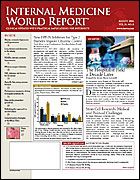Publication
Article
Intermittent Asthma Requires Aggressive Treatment
Author(s):
From the American Academy of Allergy, Asthma & Immunology
MIAMI BEACH—Patients with intermittent asthma account for almost one half of all asthma-related emergency department visits, according to new data presented at the 2006 Annual Meeting of the American Academy of Allergy, Asthma & Immunology.
Robert T. Hsu, MD, with the VA Greater Los Angeles Healthcare System, and colleagues, analyzed pharmacy and diagnostic coding records from 202 adults aged 19 to 85 years who were treated for asthma in the emergency department from April through July 2002.
Of 180 total visits for asthma, 48% involved patients with intermittent asthma, which was defined as the infrequent use of asthma controller and reliever medications (ie, <4 asthma medication prescriptions in the previous 12 months). Subgroup analysis revealed that 40% (n = 64) did not need asthma medications at all, and 36% (n = 57) who could have been taking asthma medications did not require the use of emergency medications (ie, controller nor reliever) in the year before coming to the emergency department.
IMWR
“Our findings were surprising. The ‘intermittents’ are going to the emergency room in large numbers, and this should be a wake-up call,” Dr Hsu told . “The implications of the study are that a large number of these patients are not taking any medications at all. Primary care physicians may need to have more aggressive therapy with asthma controller medications.”
Vitamin D Linked to Wheezing
A second study presented at the meeting included data from a prospective study called Project Viva, which showed that pregnant women who had higher intakes of vitamin D during pregnancy had a lower risk of giving birth to children who will develop asthma during childhood than those with low levels of the vitamin.
Although vitamin D is known to have many important immunologic benefits, its relationship to asthma had not been well studied. This recent study looked at maternal intakes of vitamin D during pregnancy (assessed via a validated food frequency questionnaire in the first and second trimesters) and the incidence of childhood wheezing events among 1306 mother–child pairs.
Mean total vitamin D intake during pregnancy was 550 IU/day. Multivariate logistic regression models that controlled for 10 factors showed that a 100-IU increase in daily maternal vitamin D intake lowered the risk of her child developing wheezing, including “any wheeze,” defined as mother-reported wheeze during years 1 or 2 of the child’s life, and “recurrent wheeze,” defined as wheeze in both years.
Further adjustment for maternal intake of fruits, vegetables, and fish did not change the results. The inverse association persisted regardless of whether vitamin D was obtained from diet or nutritional supplements.
“Women who are pregnant...need to be aware that vitamin D is something we are linking to wheezing in children, and this is another factor for physicians to consider when caring for women of childbearing age,” Carlos Camargo Jr., MD, of Harvard Medical School, Boston, told IMWR.
He added that “People have not really appreciated enough that our intake of foods with vitamin D, such as milk and fish, has declined in the last 10 years, and a lot of us live in latitudes where we can’t make enough vitamin D from the sun between November and March. If you aren’t consuming it in food or a supplement, you are at higher risk. Some women may need supplements, [which] have been shown to be effective.”
It is estimated that 20.3 million Americans have asthma, including 9 million children under the age of 18 years.






